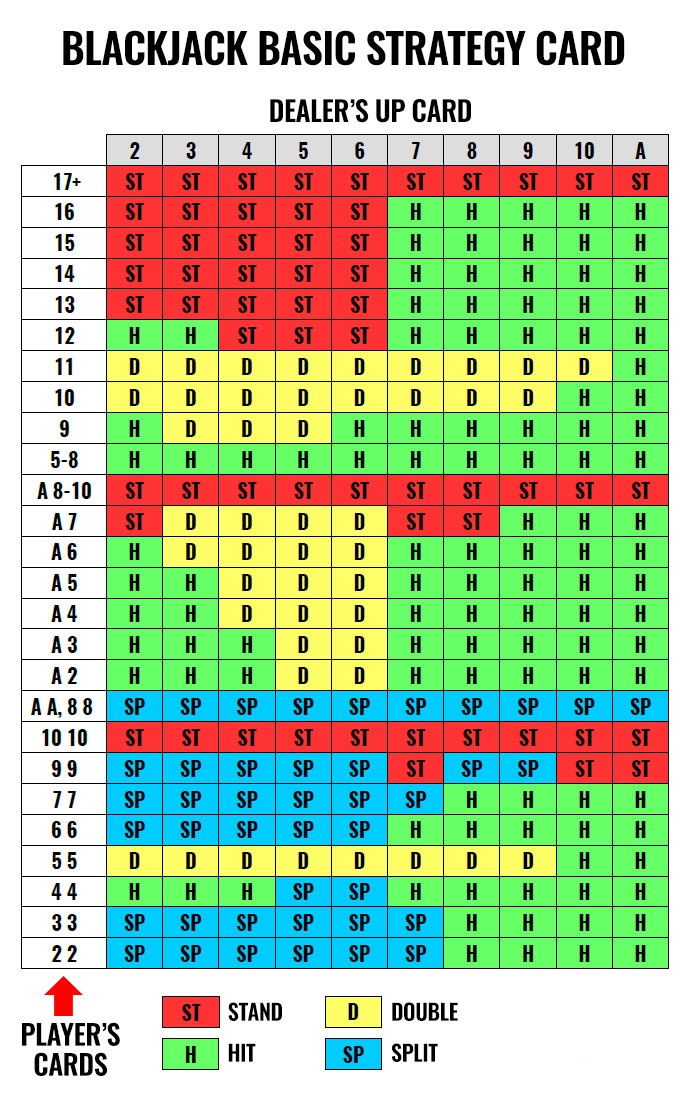If you love casino games then Bitcoin casinos are the place to be. All your favourite games are available at our recommended Bitcoin casino websites. To get you started you will find some basics on your favourite games on this page.
Contents
Blackjack
Blackjack is one of the most popular casino games available on the internet and also known as twenty-one. The goal of the game is to beat the dealer. Players do not play against each other. You have a couple of ways to beat the dealer:
- Get 21 points on the player’s first two cards (called blackjack), without a dealer blackjack.
- Reach a final score higher than the dealer without exceeding 21.
- Let the dealer draw additional cards until their hand exceeds 21.
Players are each dealt two cards, the hand’s value is the sum of the card values. Face cards (Jack, Queen and King) are all worth ten, the value of cards two through ten is their pip value (2 through 10) and Aces can be worth one or eleven. Plaers are allowed to draw additional cards to improve their hands. A hand with an ace valued as 11 is caled “soft”, meaning that the hand will not bust by taking an additional card, the value of the ace will become one to prevent the hand from exceeding 21. Otherwise, the hand is “hard”.
Once all players have completed their hands, it is the dealer’s turn. The dealer must hit until the cards value equals a total of 17 or more points. Players win by not busting and having a total higher than the dealer, or getting a blackjack without the dealer getting a blackjack. If you player and dealer have the same total (not counting blackjacks), this is called a “push” and the initial stake is returned to the player. Otherwise, the dealer wins.
Decisions
After receiving the initial two cards, the player has up to four standard options;
- Hit: take another card.
- Stand: take no more cards.
- Double down: double your bet and take exactly 1 more card.
- Split: if the first two cards of a hand have the same value you can opt to split the cards and play them as two seperate hands.
Insurance
If the dealer’s upcard is an ace, the player is offered the option of taking “insurance” before the dealer checks the hole card. Insurance is a side bet that the dealer has blackjack and is treated independently of the main wager. It pays 2:1 (meaning that the player receives two dollars for every dollar bet) and is available when the dealer’s exposed card is an ace. The idea is that the dealer’s second card has a fairly high probability (nearly one-third) to be ten-valued, giving the dealer blackjack and disappointment for the player. It is attractive (although not necessarily wise) for the player to insure against the possibility of a dealer blackjack by making a maximum “insurance” bet, in which case the “insurance proceeds” will make up for the loss on the original bet.
Basic strategy
Each blackjack game has a basic strategy, which is playing a hand of any total value against any dealer’s up-card, which loses the least money to the house in the long term. An example of basic strategy is shown below and depends on the amount of decks used, whether the dealer hits on a soft 17, if a double is allowed after a split and if only original bets are lost on a dealer blackjack.

Roulette
Roulette is a casino game named after the French word meaning little wheel. Players can place bets on a single number, various groups of numbers, the colors red and black, whether the number is odd or even, or if the number is high (19-36) or low (1-18). Bets can be either inside or outside bets which we will explain later on.
Once all bets are placed the winning number is determined by spinning a wheel in one direction and a ball in the other direction. When the ball eventuelly loses momentum it lands into one of the colored and numbered pockets on the wheel.
Inside bets
- Straight/Single: Bet on a single number by placing your chips within the square for the chosen number.
- Split: Bet on two vertically or horizontally adjecent numbers by placing your chips on the edge shared by the two numbers.
- Street: Bet on three consecutive numbers in a horizontal line by placing your chips on the outer edge of the number at either end of the line.
- Corner/Square: Bet on four numbers that meet at one corner by placing your chips on the common corner.
- Six line/Double street: Bet on six consecutive numbers that form two horizontal lines by placing your chips on the outer corner shared by the two leftmost or the two righmost numbers.
- Trio: Place a three-number bet that involves at least one zero by placing your chips on the corner shared by the three chosen numbers.
Outside bets
Outside bets typically have better odds at winning, but smaller payouts. Except, as noted, all of these bets lose is a zero comes up.
- 1 to 18 (Low or Manque) or 19-36 (High or Passe): A bet that the number will be in the chosen range.
- Red or black (Rouge ou Noir): A bet that the number will be the chosen color.
- Even or odd (Pair ou Impair): A bet that the number will be even or odd.
- Dozen bet: A bet that the number will be in the chosen dozen. (1-12, 13-24 or 25-36)
- Column bet: A bet that the number will be in the chosen column.
Baccarat
Baccarat is a card game played at casinos. Each round of play, also called a “coup”, has three possible outcomes:
- “Player”: Player has the higher score
- “Banker”: Banker has the higher score
- “Tie”: Player and Banker score are equal
There are three popular variants of the game, punto banco, baccarat chemin de fer and baccarat banque. We will explain all three variants, but let’s start with hand valuations.
Valuation of hands
In Baccarat cards have a point value: cards two through nine are worth face value (in points), tens, jacks, queens and kings have no point value (i.e. are worth zero) and aces are worth 1 point. Hands are valued according to the rightmost digit of the sum of the cards. For example; a hand consisting of a 3 and a 4 is worth 7, but a hand consisting of a 6 and 8 is worth 4, because the sum is 14. The highest possible hand value in Baccarat is therefore 9.
Punto Banco
Most online casinos offer Punto Banco baccarat. In Punto banco the casino banks the game at all times and commits to playing out both hands according to fixed drawing rules known as the “tableau”. Player (Punto) and Banker (banco) are simply designations for the two hands dealt out in each coup, two outcomes which the bettor can back. Player has no particular association with the gambler, nor Banker with the house.
For each coup, two cards are dealt face up (or equivalent) to each hand, starting from “player” and alternating between the hands. The croupier may call the total (e.g. “Five Player, three Banker”). If either Player or Banker or both achieve a total of 8 or 9 at this stage, the coup is finished and the result is announced: Player win, a Banker win, or tie. If neither hand has eight or nine, the drawing rules are applied to determine whether Player should receive a third card. Then, based on the value of any card drawn to the player, the drawing rules are applied to determine whether the Banker should receive a third card. The coup is then finished, the outcome is announced, and winning bets are paid out.
Chemin de fer
Chemin de fer was so called because it was quicker than the original game, the railway (in French: chemin de fer) being at that time the fastest means of transport.
Once play begins, one player is designated as the “banker”. This player also deals. The other players are “punters”. The position of banker passes counterclockwise in the course of the game. In each round, the banker wagers the amount he wants to risk. The other players, in order, then declare whether they will “go bank”, playing against the entire current bank with a matching wager. Only one player may “go bank”. If no one “goes bank”, players make their wagers in order. If the total wagers from the players are less than the bank, observing bystanders may also wager up to the amount of the bank. If the total wagers from the players are greater than the bank, the banker may choose to increase the bank to match; if he does not, the excess wagers are removed in reverse play order.
The banker deals four cards face down: two to himself and two held in common by the remaining players. The player with the highest individual wager (or first in play order if tied for highest wager) is selected to represent the group of non-banker players. The banker and player both look at their cards; if either has an eight or a nine, this is immediately announced and the hands are turned face-up and compared. If neither hand is an eight or nine, the player has a choice to accept or refuse a third card; if accepted, it is dealt face-up.
After the player makes his decision, the banker in turn decides either to accept or to refuse another card. Once both the banker and the representative player have made their decision, the hands are turned face-up and compared.
If the player’s hand exceeds the banker’s hand when they are compared, each wagering player receives back their wager and a matching amount from the bank, and the position of banker passes to the next player in order. If the banker’s hand exceeds the player’s hand, all wagers are forfeit and placed into the bank, and the banker position does not change. If there is a tie, wagers remain as they are for the next hand.
Baccarat Banque
In Baccarat Chemin de Fer, a given bank only continues so long as the banker wins. As soon as he loses, it passes to another player. In Baccarat Banque the position of banker is much more permanent. Three packs of cards are shuffled together. The banker (unless he retires either of his own free will or by reason of the exhaustion of his finances) holds office until all these cards have been dealt.
The banker takes his place midway down one of the sides of an oval table. On either side of the banker are the punters (ten such constituting a full table). Any other persons desiring to take part remain standing, and can only play in the event of the amount in the bank for the time being not being covered by the seated players.
Each punter having made his stake, the banker deals three cards, the first to the player on his right, the second to the player on his left, and the third to himself; then three more in like manner. The five punters on the right (and any bystanders staking with them) win or lose by the cards dealt to that side; the five others by the cards dealt to the left side. The rules as to turning up with eight or nine, offering and accepting cards, and so on, are the same as at Baccarat Chemin de Fer.
Each punter continues to hold the cards for his side so long as he wins or ties. If he loses, the next hand is dealt to the player next following him in rotation. Any player may “go bank”, the first claim to do so belonging to the punter immediately on the right of the banker; the next to the player on his left, and so on alternatively in regular order. If two players on opposite sides desire to “go bank”, they go half shares.
A player going bank may either do so on a single hand, in the ordinary course, or a cheval, i.e. on two hands separately, one-half of the stake being played upon each hand. A player going bank and losing may again go bank, and if he again loses, may go bank a third time, but not further. A player undertaking to hold the bank must play out one hand, but may retire at any time afterwards. On retiring, he is bound to state the amount with which he retires. It is then open to any other player (in order of rotation) to continue the bank, starting with the same amount, and dealing from the remainder of the pack, used by his predecessor. The outgoing banker takes the place previously occupied by his successor. The breaking of the bank does not deprive the banker of the right to continue, provided that he has funds with which to replenish it, up to the agreed minimum.
Should the stakes of the punters exceed the amount for the time being in the bank, the banker is not responsible for the amount of such excess. In the event of his losing, the croupier pays the punters in order of rotation, so far as the funds in the bank will extend; beyond this, they have no claim. The banker may, however, in such a case, instead of resting on his right, declare the stakes accepted, forthwith putting up the needful funds to meet them. In such event the bank thenceforth becomes unlimited, and the banker must hold all stakes (to whatever amount) offered on any subsequent hand, or give up the bank.
Bingo
Bingo is a game of chance in which each player matches numbers pre-printed in different arrangements on 5×5 cards with the numbers the game host draws at random, marking the selected numbers with tiles. When a player finds the selected numbers are arranged on their card in a row, they call out “Bingo!” to alert all participants to a winning card.
Players compete against one another to be the first to have a winning arrangement for the prize or jackpot. After a winner is declared, the players clear their number cards of the tiles and the game host begins a new round of play.
The most common Bingo cards which contain 25 squares arranged in five vertical columns and five side to side rows. Each space in the grid contains a number. A typical Bingo game utilizes the numbers 1 through 75. The five columns of the card are labeled ‘B’, ‘I’, ‘N’, ‘G’, and ‘O’ from left to right. The center space is usually marked “Free” or “Free Space”, and is considered automatically filled. The range of printed numbers that can appear on the card is normally restricted by column, with the ‘B’ column only containing numbers between 1 and 15 inclusive, the ‘I’ column containing only 16 through 30, ‘N’ containing 31 through 45, ‘G’ containing 46 through 60, and ‘O’ containing 61 through 75.
Single games often have multiple bingos; for example, the players first play for a single line; after that, play goes on until a full card is called. Players are also allowed to play multiple cards per game increasing their odds to win.
Slots
A slot machine or simply slot is a gambling machine with three or more reels which spin when a button is pushed. The machine pays of according to patterns of symbols visible on the front of the machine when it stops. If a player matches a combination according to the rules of the game, the slot machine credits the player cash or some other sort of value, such as free spins or extra games. Free spins are a common feature in modern slot games allowing the user to spin the machine’s reels without charge. Many online Bitcoin casinos advertise their free spin rewards and emphasize this feature.
Multi-line slot machines have become more popular since the 1990s. These machines have more than one payline, meaning that visible symbols that are not aligned on the main horizontal may be considered for winning combinations. Some slot machines offer up to 243 different paylines. Almost all slot machines also have a themed game, some of which feature graphics and music based on popular entertainers, motion pictures or TV programs. Most accept variable numbers of credits to play, with 1 to 15 credits per line being typical. The higher the amount bet, the higher the payout will be if the player wins.


